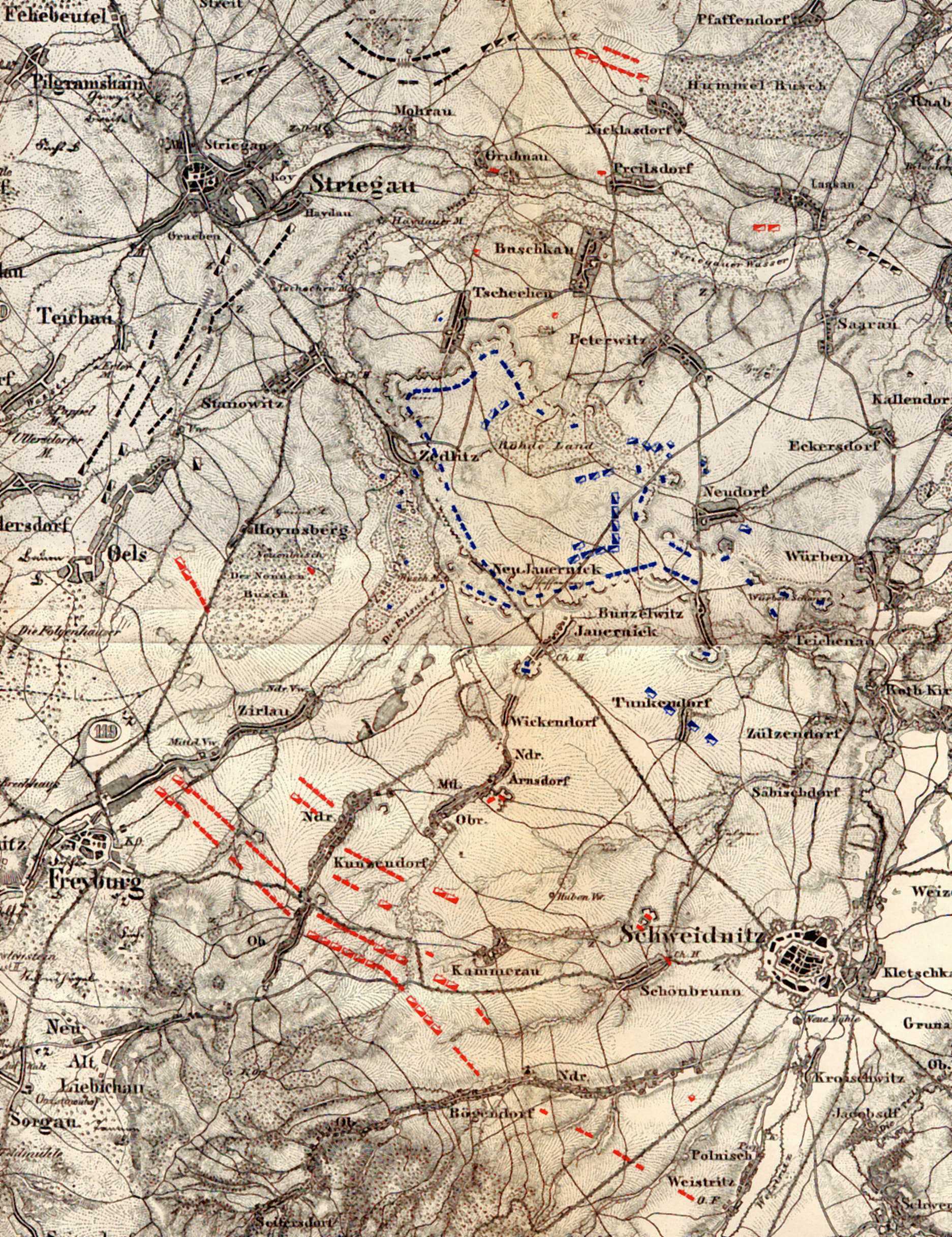
The Camp of Bunzelwitz 1761
Map and Details of the Camp
The period from August until September 1761 when Frederick the Great and his army were in the fortified camp at Bunzelwitz near Schweidnitz in Silesia was the most dangerous time of all for the King and the Prussian Monarchy during the Seven Years War. His army of 53,000 men was almost surrounded by a combined Austrian and Russian force comprising some 130,000 combatants. Although the Prussians fortified and strengthened the camp by all available means, the position for Frederick was precarious; the allies did not attack, because there was no single commander and the Russians were reluctant to take part in an attack- the Empress Elizabeth had sent a message to the army in June during its march through Poland indicating that she would be pleased to see it return intact to Russia; in addition many of the generals were reluctant to mount such an attack, and the situation at St. Petersburg, where the empress was in failing health, meant that many officers were looking to the future as her successor was pro-Prussian. The Austrian commander Feldzeugmeister Freiherr von Laudon did draw up a detailed plan for a massive assault on the Prussians which would have had a very good chance of total success, but the Russians refused to take part. They then marched back across the Oder, citing supply difficulties as the reason- in fact the whole area had been stripped of all available fodder and the huge armies could no longer feed their horses. Laudon was able to salvage something from what had been a frustrating campaign for the Austrians in Silesia by storming the Prussian- held fortress of Schweidnitz in October, with the result that for the first time in the war Austria held significant areas of Silesia over the winter, forcing Frederick to spend the winter in Silesia instead of Saxony as he had wanted.
Map of the Camp of Bunzelwitz
(with the Austrian and Russian positions)

(Prussians - Blue; Austrians - Red; Russians - Black)
(Note: there was an Austrian cavalry detachment off the south edge of the above map on the road from Polnisch Weistritz, and some Russian cavalry off the east edge, north-east of Kallendorf.)
The Prussians began digging in at the Bunzelwitz position on 21st August. The position was based on some low hills, except at Würben where the slopes were somewhat steeper; everything possible was done to increase the defensibility of the camp- the earthworks were protected with Spanische Reiter (chevaux de frise), Wolfsgruben ("Trous de loup", pits up to six feet wide and six feet deep with a sharpened stake at the bottom, these were often covered with light hurdles and a thin layer of soil), stakes at various points, and Fladderminen (mines) for the more exposed works. In addition the approaches limited any attackers` options to some extent, with numerous streams and their wet valley floors channeling or blocking any advance. The King had available 65½ battalions, 110 squadrons, over 400 guns of all types (including some brought from Schweidnitz), with a total of some 53,000 men. From Stanowitz to Würben the position had a length of 14,000 paces, and the greatest depth around Jauernig was 6,000 paces. The circumference of the entrenched area (not including the advanced works at the south end of Bunzelwitz and at Jauernig) was 26.5 km. The entire infantry and 16 squadrons of cavalry were spread along the line of fortifications (except for short stretch between the Busch-Mühle and the Pfaffen-Berg). Forward of the Pfaffen-Berg there were 5 squadrons at Neudorf and 20 squadrons at Tunkendorf, these two detachments covered the communications with Schweidnitz. 15 squadrons were deployed as a special reserve for the right wing, and this left 54 squadrons (5,400 men) as a general reserve.
A mass assault by the allies would surely have overrun the Prussians, albeit at great cost.
Website "The Seven Years war 1756-63"
©Martin Tomczak 2003